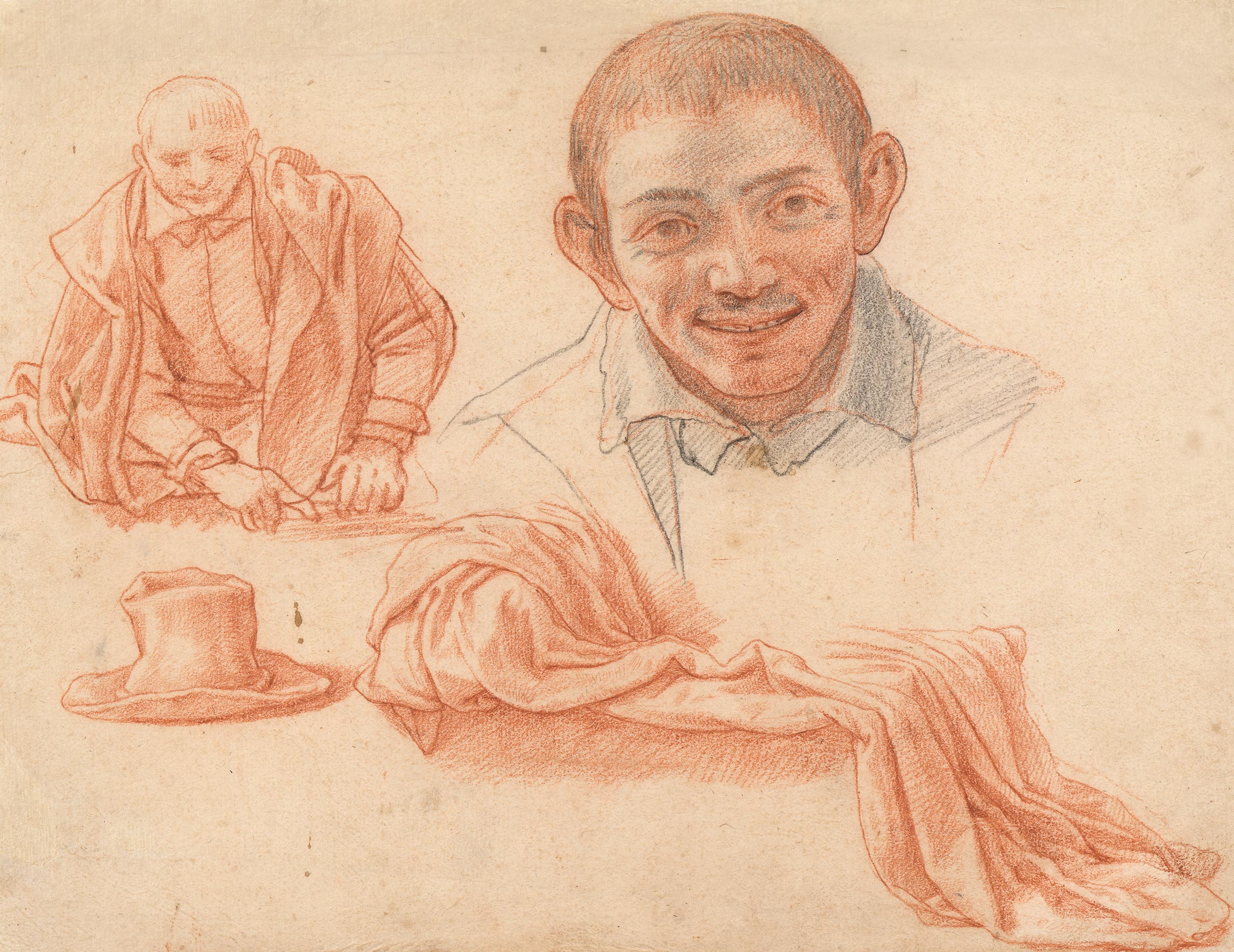
Florentine School
Early 17th century
Sheet of studies with the head of a man, a man in half-length, a drapery study and a hat
Red and black chalk, watermark M and star in a shield.
240 x 317 mm (9 3/8 x 12 3/8 in)
This sheet of studies, which is undoubtedly Florentine dating to the very beginning of the 17th century, is typical of the draughtsmanship of artists who created multiple studies of drapery, anatomy and faces, in the wake of Caravaggism, the Carracci reform in Bologna and the needs of the Counter Reformation in the artistic domain. It is sometimes hard to identify the authors of these study drawings and in the case of our sheet, various names come to mind. This manner of combining red and black chalk is marked by the significant influence of Federico Zuccaro (1543 – 1609), especially in the very beautiful portrait of his brother Taddeo seen in profile (Louvre, Département des Arts Graphiques, inv. 4591): there, we see a similar manner of defining the contours and mixing the black and red chalks with fine hatching in order to give the skin a lively and realistic colour, a similar interest in naturalistic details, such as the small wrinkles of the corner of the eyes and the folds of the skin. In our sheet, like in those by Zuccaro, the liveliness of the gaze and the sincerity of expression are exceptional.
Many artists in Rome and Florence benefited from the lesson of Zuccaro. Cavaliere d’Arpino, Cristofano Allori, Santi di Tito, Matteo Rosselli, Cosimo Gamberucci, and later Carlo Dolci, used this combination of red and black chalks to give their portraits the full illusion of life. Santi di Tito, who had worked in Rome with Zuccaro and who had one of the most popular studios in Florence, seems to have been a conduit of the first order in the circulation of this manner of drawing. However, none of these artists of which we think in the first instance, who supported this manner that was so characteristic, seems to be the author of this sheet. Either the hand reveals some incompatible differences of handling, or our sheet shows itself to be of much better quality in its frank spontaneity and the timeless proximity it creates between the model and the viewer.
The three red chalk studies – the young man, the hat and the drapery – have no equivalents in the graphic production of Zuccaro. These sketches are closer to the exercises in observation drawings developed in Florence workshops, in particular that of Santi di Tito. They are reminiscent of Matteo Rosselli or Cosimo Gamberucci. At the Louvre, a Head of an Old Man by Matteo Rosselli, preparatory for a figure in the Last Supper painted in 1634 in the refectory of the Abbey of Montesenario, is closer to our drawing. But the most comparable studies to ours, given the current state of knowledge, are those of Teofilo Torri1, contained in an album located at Arezzo.2 It contains sheets comprising various studies of figures sitting or standing, of faces and portraits with direct, animated expressions. Although the style of this painter from Arezzo, who was a pupil of Giorgio Vasari, is more laborious than that in our sheet, his drawings share with ours a real common sensitivity and an atmosphere that is both slightly rustic and profoundly sensitive.
- We are very grateful to Catherine Goguel who was the first to suggest we look among some less common Tuscan artists, and who suggested the name Teofilo Torri, with a few others, which we are delighted to have discovered.
- Luciana Borri Cristelli, I disegni della Collezione Torri nella Biblioteca di Arezzo, Siena, Università degli Studi – Cattedra di storia dell’arte, Arezzo, Facoltà di magistero, Biblioteca della Città di Arezzo, 1986.

